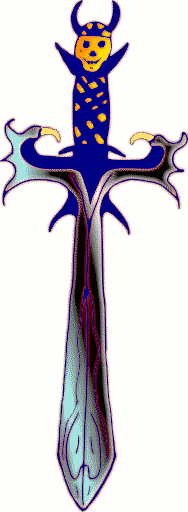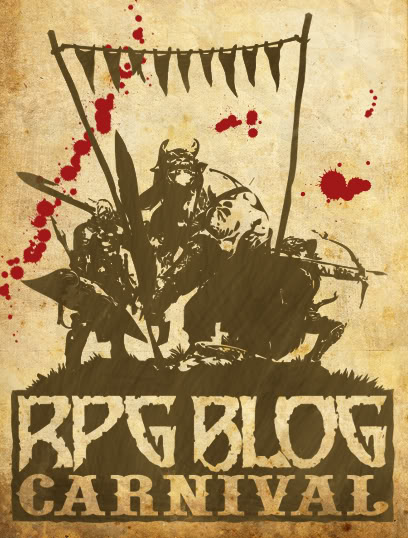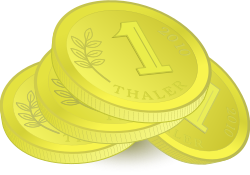 This post is part of the Got Loot RPG Blog Festival. Make sure to check out the other posts under the banner of this festival!
This post is part of the Got Loot RPG Blog Festival. Make sure to check out the other posts under the banner of this festival!
The dragon’s hoard. The very image of a dragon’s hoard is sure to draw immediate visions grandeur to any fantasy gamer’s head. Think about it for a moment, what images came to your mind when you read the title of this post?
I remember as a kid thinking of that huge red dragon dwelling in some deep, dark cavern lit by the glow of dimming embers from some unknown source. The floor of the cavern mounded high with coins, a mound that rivaled the size of the small hill at the local park. Amidst the near uncountable coin pile were more treasures – portions of armor, shields, swords of unknown legend, rings, chests and don’t forget the gems of a dizzying array of colors.
These images of a dragon’s riches have been a staple of fantasy for a long time. Smaug from The Hobbit was the first dragon to conjure this image for me. Later reading of various D&D rulebooks and monster tomes further cemented this thought of great red dragons sitting atop piles of riches.
That was then, this is now
Of course as we gamers play the game longer some of the things that once held mystery and excitement become the mundane. After defeating the great red dragon its treasure hoard becomes simply a pile of game statistics. How many gold coins, how many silver coins? Then a series of detect magics for sorting the magical items from the non-magical items which is soon followed by a series of identify spells and spellcraft checks to figure out just how many pluses and special abilities does that glowing sword have.
Treasure becoming mundane is not just a problem with dragon hoards. It is just the prime example of if even the dragon’s hoard can become mundane, loot held by other creatures during the course of a gaming adventure has no chance.
In fact I have posted previously about this issue in my Putting the Magic Back article just a month ago. That article was a broader look at magic items becoming mundane, here we will be focusing in on the dragon’s hoard and bringing the magic and mystery back to it.
Turning it around
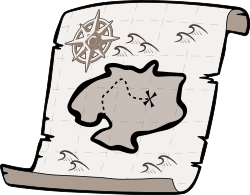 Where do we start as a GM? What can we do to put the wonder back into this hoard of treasure the heroes are going to get when they put an end to that evil red dragon living under the mountain?
Where do we start as a GM? What can we do to put the wonder back into this hoard of treasure the heroes are going to get when they put an end to that evil red dragon living under the mountain?
First, as the GM you must embrace the wonderful opportunity you have to make this dragon hoard part of something much more! This is your chance to introduce plot hooks galore or simply offer ways to explore the history of your world.
The ordinary
Let’s take a look at the more predominant item in the dragon’s hoard – gold coins! Lots of them! This dragon has been the terror of this region of your world for many years, right? It will only make sense that the coins in this hoard will not be ones the party is used to seeing in day to day exchanges. There will be coins from ancient civilizations. Describe some of these coins to the party as they find them. Note unusual depictions, perhaps of great structures that no longer exist or that serve to make the characters curious. Some of the coins are likely to have the visage of great leaders, or perhaps dictators of years past. Use these coins to build depth to your world with its histories and tie-ins to your present time in your world.
The hoard is quite likely to also contain normal objects from a different era as well. Lanterns of an old style, masterwork leather backpacks with unusual cuts or design and other such items a dragon is bound to accumulate over the years. Take a little extra time to write some short descriptions for some of these items. The extra attention to detail here will help convey a sense of age to this hoard.
The magical
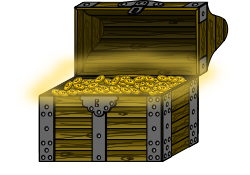 Any dragon hoard worth its merit will have a plethora of magical items. Take some time as a GM and give a few of these items some stories. Not every magical item needs such detail but use enough to spice up the hoard with flavor.
Any dragon hoard worth its merit will have a plethora of magical items. Take some time as a GM and give a few of these items some stories. Not every magical item needs such detail but use enough to spice up the hoard with flavor.
That bastard sword with the unusual carving in the hilt, how did it get there? Perhaps a hero that fell to the dragon’s breath many years ago? Maybe the sword has a hidden opening in the pommel to hold something of personal value to the original hero that carried it, or maybe the sword is an intelligent sword to be unlocked and recant past tales of the hero, tales that could lead this current set of characters on to other locations and treasures.
That Bag of Holding that you find in the hoard, certainly it isn’t empty. Perhaps it held the belongings of another fallen hero. Belongings that may be magical in nature, or maybe it holds a normal walking stick that has carvings from the travelers day on the road.
The near complete skeleton found at the edge of the treasure hoard, the one with singed leather armor and torn backpack. Inside that backpack is an incomplete letter back home, perhaps a letter talking of the final days leading up to this adventurer’s assault on the dragon’s lair that ended so direly for him. The current party can end up with a feeling of others who have fell to the dragon’s wrath and possibly be motivated to return these remains to the fallen’s family.
Bringing it together
I have made several suggestions on how to make the dragon’s hoard a little more mysterious and magical. The hoard can serve many roles to a GM willing to put some extra time into the details. These small details can serve as the spice to build verisimilitude in your world, to introduce other hooks for the characters and so many other things. In addition to providing the GM powerful tools to further the campaign, they can equally serve to make the dragon hoard mysterious and wondrous again!


